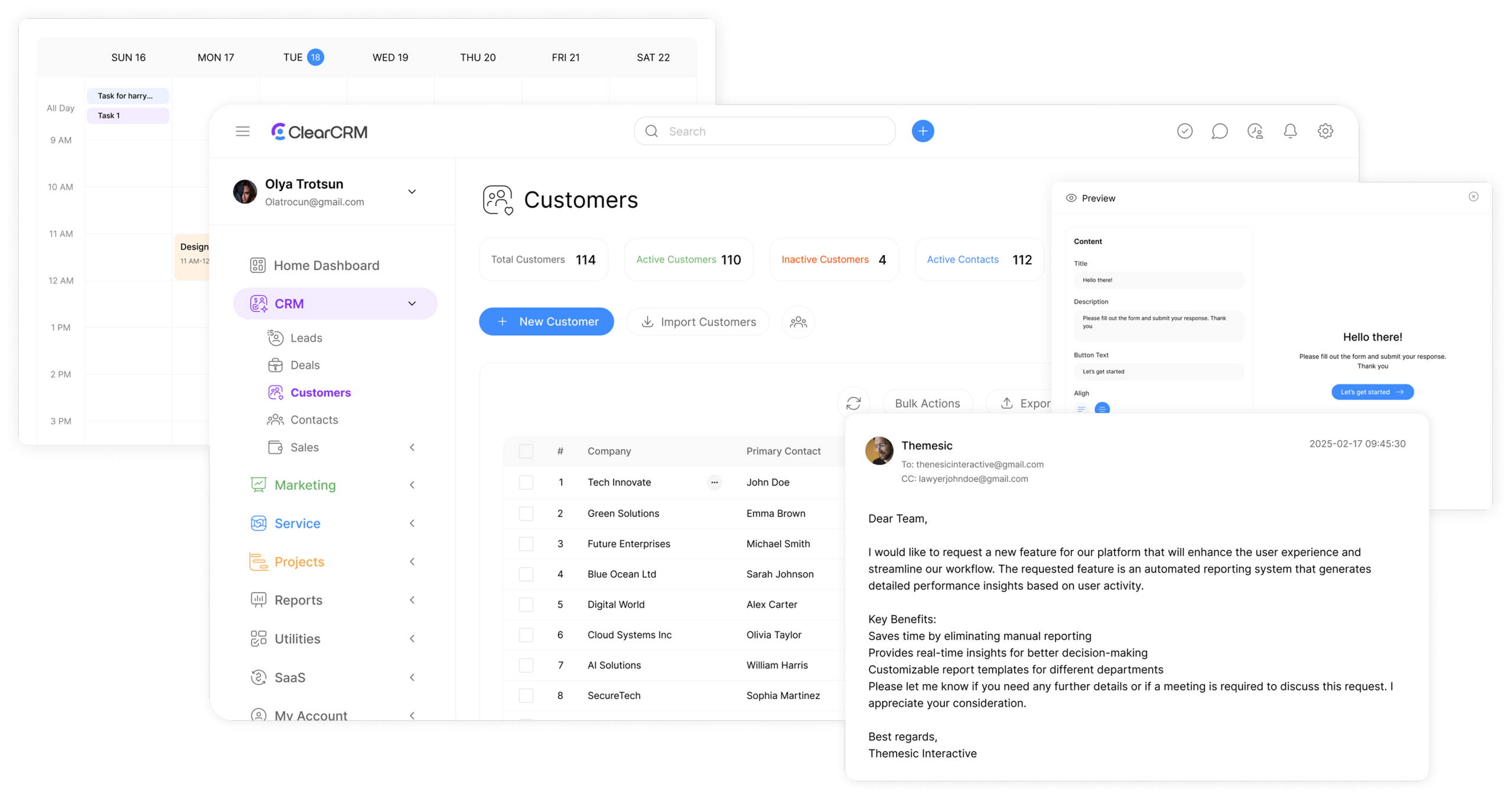Effective Lead Organization for Better Sales Growth

The harsh reality in healthcare is that no single organization can effectively help everyone due to the unique nature of each healthcare journey. Many healthcare organizations struggle with reaching the right people, resulting in a high volume of low-quality leads that aren’t converting into booked appointments.
To address this challenge, businesses need to focus on streamlining their sales process and improving conversion rates. Effective lead management is crucial today in a competitive market, allowing companies to quickly segment and filter potential customers based on relevant criteria. By leveraging technology, businesses can master advanced lead filters, enabling them to identify high-quality leads more efficiently. This targeted approach not only enhances the effectiveness of their marketing efforts but also fosters stronger relationships with customers by delivering personalized experiences. As a result, companies can maximize their return on investment and achieve sustainable growth in an ever-evolving marketplace. Investing in the right tools can significantly enhance these efforts. By leveraging top lead management software options, businesses can automate tedious tasks, ensuring that their sales teams spend more time engaging with qualified leads. Furthermore, these systems often provide valuable insights and analytics, aiding in the continuous refinement of sales strategies for better outcomes.
Key Takeaways
- Effective lead organization is essential for businesses to improve conversion rates.
- Streamlining the sales process helps in focusing on high-quality leads.
- Segmenting and filtering leads based on relevant criteria enhances sales efficiency.
- Poor lead management results in wasted resources and missed opportunities.
- Mastering lead organization improves sales efficiency and marketing ROI.
The Power of Enhanced Lead Organization

Businesses that master lead organization are better positioned to convert prospects into customers. In today’s fast-paced digital landscape, the ability to efficiently manage and organize leads is crucial for driving sales success and maximizing marketing investments.
Why Effective Lead Organization Matters
Effective lead organization serves as the foundation for successful sales and marketing alignment. When leads are properly organized, businesses can implement targeted marketing strategies that speak directly to specific segments, increasing engagement and conversion rates. This alignment enables teams to work together more efficiently with a shared understanding of lead quality and priority.
| Benefits of Lead Organization | Description |
|---|---|
| Increased Efficiency | Streamlined processes for sales and marketing teams |
| Improved Conversion Rates | Targeted marketing strategies for specific lead segments |
| Enhanced Lead Quality | Clear criteria for evaluating lead quality |
The Impact of Poor Lead Management on Sales Performance
Poor lead management often results in sales teams wasting valuable time pursuing unqualified prospects while high-potential leads grow cold from lack of attention. This mismanagement can lead to decreased sales performance and a significant impact on the bottom line. By implementing effective lead organization, businesses can avoid these pitfalls and ensure that their sales teams are focusing on high-quality leads.
Today’s digital marketing landscape generates more leads than ever before, making effective organization not just helpful but essential for businesses hoping to capitalize on their marketing investments. By leveraging technology solutions for lead management, businesses can automate tasks such as tagging, scoring, and prioritization, saving countless hours of manual work.
Understanding Your Current Lead Management Process
Before diving into new lead organization systems, evaluating your current process is essential. This step involves a thorough assessment of how leads are currently being managed within your organization.
Evaluating Your Existing Lead Organization System
To start, map out your current lead management workflow from initial capture through qualification, nurturing, and handoff to sales. This process will help identify bottlenecks and inefficiencies. Many organizations discover that their current approach involves too many manual steps, creating opportunities for leads to fall through the cracks. By evaluating your existing lead data, you can determine where good leads come from and areas that need improvement.
| Lead Source | Conversion Rate | Quality of Leads |
|---|---|---|
| PPC | 20% | High |
| Facebook Ads | 15% | Medium |
| Organic Search | 25% | High |
Identifying Common Pain Points in Lead Management
Common pain points include inconsistent tagging practices, lack of clear ownership between marketing and sales teams, and insufficient tools for proper segmentation. Technology limitations also contribute to these challenges, with many businesses using systems not designed for today’s sophisticated marketing requirements. Input from people across departments who interact with leads at different points in the customer journey is crucial during the evaluation process.
By understanding your current lead management process, you can identify areas for improvement and develop a more effective strategy. Quantitative metrics like conversion rates and qualitative feedback from sales representatives provide valuable insights into your current system’s performance. Getting started with lead organization improvement requires an honest assessment of your current state before determining where you need to go. A little time invested in understanding your process will save significant resources when implementing new strategies.
Creating a Strategic Framework for Lead Organization
Creating a robust framework for lead organization enables businesses to categorize and manage leads more efficiently. This framework is essential for aligning lead management processes with overall business objectives, ensuring that the sales team can focus on high-value leads.
Defining Your Ideal Customer Profiles
Defining Ideal Customer Profiles (ICPs) is a critical step in creating a strategic framework for lead organization. ICPs help businesses identify their most valuable customers and tailor their marketing efforts accordingly. To develop detailed ICPs, input from multiple teams, including sales, marketing, customer success, and product development, is necessary. This collaborative approach ensures a comprehensive understanding of the characteristics and needs of the best customers.
Researching the ideal customer involves understanding their needs, preferences, and behaviors. This can be achieved through customer surveys, market research, and one-on-one customer interviews. By gathering this information, businesses can create targeted marketing strategies that resonate with their ideal customers.
Mapping the Customer Journey for Better Lead Categorization

Mapping the customer journey is another crucial aspect of lead organization. It provides context for lead categorization, helping businesses understand where each lead stands in their buying process and what information they need next. By aligning the lead organization framework with the customer journey, companies can ensure that their marketing efforts are tailored to the specific needs of each lead.
A strategic framework for lead organization should include standardized definitions for lead stages and qualification criteria. This eliminates confusion and ensures consistency in how leads are categorized across the organization. The framework should also include a clear process for how leads move between stages and departments, with specific triggers that indicate when a lead is ready to advance.
To implement this framework effectively, it’s essential that people throughout the organization understand and buy into the strategy. Cross-team training and communication are vital for ensuring that everyone is aligned and working towards the same goals. A little bit of flexibility should be built into the framework to accommodate different types of leads and buying processes while maintaining overall structure.
The tools selected for implementing the lead organization framework should support the defined process rather than forcing the business to adapt its strategy to fit the technology. By aligning the framework with the right tools, companies can maximize the value of their lead organization efforts and drive better sales performance.
Essential Lead Tagging Strategies
Lead tagging is the backbone of a successful lead organization system, enabling precise targeting and personalization. By categorizing contacts based on multiple dimensions, businesses can significantly enhance their marketing efforts and improve customer engagement.
Demographic vs. Behavioral Tagging
There are two primary approaches to lead tagging: demographic and behavioral. Demographic tagging focuses on the characteristics of the lead, such as industry, company size, and job title. On the other hand, behavioral tagging captures the actions and behaviors of leads, including content downloaded, pages visited, and webinars attended.
Both approaches are crucial for a comprehensive understanding of leads. By combining demographic and behavioral data, businesses can create a more nuanced and accurate profile of their leads, enabling more effective targeting and personalization.
Creating a Standardized Tagging Taxonomy
A standardized tagging taxonomy is essential for maintaining consistency across the organization. This involves establishing a clear and coordinated system for tag creation and application, ensuring that different team members do not create conflicting or redundant tags.
To achieve this, organizations should limit tag creation authority to a small, designated group while providing a mechanism for other team members to request new tags as needed. Regular audits of the tagging system are also vital to prevent tag proliferation and ensure that obsolete or redundant tags are removed.
Effective lead tagging strategies are not one-size-fits-all; they must be tailored to the specific needs and goals of the organization. By leveraging both manual and automated tagging capabilities, businesses can create a robust and flexible tagging system that evolves with their marketing efforts.
Implementing an Effective Lead Scoring System

To maximize sales efficiency, companies need to adopt a robust lead scoring system that accurately predicts conversion likelihood. A lead scoring system is a method of ranking leads based on their behavior, fit, and other characteristics to determine their potential to become customers.
Quantitative vs. Qualitative Scoring Methods
Effective lead scoring systems combine quantitative factors, such as the number of website visits and email opens, with qualitative elements, like expressed pain points and budget discussions, for a comprehensive evaluation. Quantitative scoring methods provide a numerical value to leads based on their actions, while qualitative scoring methods assess the lead’s intent and readiness to buy.
By integrating both quantitative and qualitative scoring methods, businesses can gain a more accurate understanding of their leads’ potential. For instance, a lead who has visited the pricing page multiple times and has engaged with the sales team may be considered a high-quality lead.
Automating Your Lead Scoring Process
Today’s CRM system capabilities make it possible to automate much of the lead scoring process, with points automatically assigned based on predefined actions and attributes. Automation enables businesses to streamline their lead scoring process, reducing manual errors and increasing efficiency.
By leveraging automation, companies can also analyze large datasets to identify patterns and trends that inform their lead scoring model. For example, call tracking and analytical software, like Invoca and Liine, can help identify the source of poor lead quality by analyzing call recordings and identifying common trends.
Research into sales history is essential for developing an effective scoring model, analyzing past successful conversions to identify the common characteristics and behaviors of buyers. Organizations typically start with a simple scoring model and refine it over time as they gather more data about which factors truly correlate with sales success.
Advanced Lead Segmentation Techniques
Effective lead segmentation is crucial for businesses aiming to personalize their marketing efforts and improve sales outcomes. By dividing leads into more refined categories, organizations can tailor their approaches to better meet the needs of their potential customers.
Advanced lead segmentation goes beyond basic categorization, enabling businesses to create highly specific groupings based on multiple dimensions. This approach allows for truly personalized marketing and sales strategies, enhancing the overall customer experience and increasing the likelihood of conversion.

Segmenting by Buyer Intent and Engagement Level
Segmenting leads by their buyer intent and engagement level provides valuable insights into their readiness to purchase. By identifying leads who are actively researching solutions versus those who are just beginning to recognize their needs, businesses can tailor their communications and content to match the lead’s stage in the buying process.
- Identify leads who are actively researching solutions and prioritize them for more immediate follow-up.
- Develop content that addresses the specific needs and concerns of leads at different stages of the buying process.
- Use engagement-based segmentation to distinguish between highly engaged prospects and those who have shown minimal interest.
Creating Dynamic Lead Segments for Targeted Marketing
Dynamic lead segments automatically update as leads’ behaviors and attributes change, ensuring that people always receive messaging appropriate to their current stage in the buying process. This approach enables businesses to maintain a high level of personalization and relevance in their marketing efforts.
By leveraging technology and advanced segmentation tools, organizations can implement complex segmentation rules that would have been impossible to manage manually. This not only enhances the efficiency of the marketing team but also improves the overall quality of lead engagement.
To maximize the benefits of advanced lead segmentation, businesses should view it as an ongoing process rather than a one-time exercise. Regular refinement based on performance data and changing market conditions is crucial for maintaining effective segmentation strategies.
Optimizing Your CRM for Enhanced Lead Organization

To maximize the potential of your lead organization efforts, CRM optimization is key. The CRM system serves as the central nervous system for lead organization, making proper configuration and customization essential for effective lead management.
Most out-of-the-box ClearCRM implementations require significant customization to support sophisticated lead organization strategies that align with your specific sales process. Customizing CRM fields allows you to capture and organize the exact information your team needs to properly classify and prioritize leads based on your unique business requirements.
Customizing CRM Fields for Better Lead Classification
Customizing CRM fields is a critical step in enhancing lead organization. By tailoring fields to your specific needs, you can ensure that your team has access to the information they need to effectively manage leads. This customization enables better lead classification, making it easier to identify top priority leads and allocate resources accordingly.
For instance, you can create custom fields to capture specific demographic or behavioral data about your leads, allowing for more precise segmentation and targeting. This level of customization can significantly improve the quality of your lead data and enhance your overall lead management strategy.
Setting Up Automated Workflows for Lead Management
Automated workflows are another crucial aspect of ClearCRM optimization for lead organization. By setting up automated workflows, you can eliminate manual steps in the lead management process, ensuring consistent handling of leads and reducing the risk that promising opportunities will fall through the cracks.
Automated workflows can be used to trigger follow-up actions, assign leads to sales representatives, and update lead statuses. This automation not only streamlines the lead management process but also enables your team to focus on high-value activities such as engaging with leads and closing deals. For more information on how CRM automation can benefit your business, visit our blog post on how CRM automation can turn your business into a sales and retention.
By optimizing your ClearCRM for enhanced lead organization, you can improve the efficiency and effectiveness of your lead management efforts, ultimately driving better sales outcomes and business growth.
Developing a Lead Nurturing Strategy Based on Segmentation
Effective lead nurturing is not just about sending emails; it’s about creating a personalized journey for each lead segment, fostering a deeper connection with potential customers. As segmentation transforms from a static organizational tool into an active strategy, businesses can move prospects through the buying journey with targeted communications.
Lead nurturing transforms segmentation from a static organizational tool into an active strategy that moves prospects through the buying journey with targeted communications. By recognizing that different lead segments require different content, messaging, and engagement approaches based on their specific needs and interests, businesses can create more effective nurturing campaigns.
Personalized Nurture Paths for Different Segments
Creating personalized nurture paths for each major segment dramatically increases engagement compared to one-size-fits-all nurturing campaigns. Today’s marketing automation platforms make it possible to implement sophisticated nurturing workflows that respond dynamically to lead behaviors and changing attributes.
For instance, a business can use marketing automation to tailor the nurturing process based on the lead’s interaction with previous communications, ensuring that the content remains relevant and engaging. This approach not only enhances the customer experience but also increases the likelihood of conversion.
Timing and Frequency Considerations
The timing and frequency of nurturing communications significantly impact their effectiveness. Research shows that properly timed messages can double or triple response rates. Organizations that excel at lead nurturing typically see higher conversion rates from marketing-qualified leads to sales-qualified leads, addressing the common “leaky funnel” problem.
To optimize lead nurturing, businesses must focus on providing genuine value in each communication rather than simply pushing for a sale. People respond best to nurturing sequences that acknowledge their specific pain points and demonstrate understanding of their unique situation and challenges.
By implementing these strategies, businesses can nurture leads at scale while maintaining personalization, a key competitive advantage in markets with high volume leads and complex buying decisions.
Measuring the Success of Your Lead Organization Efforts
Measuring the success of your lead organization strategy requires a comprehensive approach that goes beyond merely counting the number of leads. It involves assessing the quality, efficiency, and ultimate business impact of your lead management processes.
Key Metrics for Evaluating Lead Management
To effectively measure lead organization success, several key performance indicators (KPIs) should be tracked. These include:
- Lead Velocity Rate: The month-over-month growth in qualified leads, providing insight into the effectiveness of your lead generation and qualification processes.
- Conversion Rate: The percentage of leads that convert into customers, indicating the quality of leads and the efficiency of your sales process.
- Customer Acquisition Cost (CAC): The total cost of acquiring a new customer, helping to evaluate the financial efficiency of your lead organization and sales efforts.
- Revenue Contribution: The revenue generated from leads, demonstrating the direct impact of your lead organization strategy on business revenue.
Using Analytics to Refine Your Strategy
Analytics play a crucial role in refining your lead organization strategy. By analyzing lead data, you can identify bottlenecks in your process, optimize your channel mix, and improve the quality of your leads. Regular analysis of lead quality by source helps in optimizing marketing efforts and potentially reducing overall lead volume while increasing qualified leads and conversions.
Moreover, time-based metrics such as lead aging and conversion time by stage help identify areas where leads are getting stuck, pointing to opportunities for improvement. A little segmentation in your analytics can reveal valuable insights that might be hidden in aggregate data.
Cross-Functional Alignment: Marketing and Sales Collaboration

Cross-functional alignment between marketing and sales teams is the key to successful lead management. When both teams work together seamlessly, they can ensure that leads are properly qualified, routed, and nurtured throughout the buyer’s journey.
This alignment is crucial because it eliminates confusion and finger-pointing that often occurs when marketing and sales teams operate with different qualification criteria. By creating shared definitions for lead stages, such as Marketing Qualified Leads (MQL) and Sales Qualified Leads (SQL), both teams can be on the same page, ensuring a smoother transition of leads.
Creating Shared Definitions and Lead Qualification Criteria
Establishing common language and criteria for lead qualification is vital. This involves defining what constitutes an MQL and an SQL, and ensuring that both teams understand these definitions. By doing so, organizations can avoid misunderstandings and ensure that leads are properly vetted before being passed to sales.
Research has shown that organizations with strong marketing-sales alignment generate 208% more revenue from their marketing efforts. This demonstrates the significant business value of collaboration between these two critical teams.
Establishing Clear Handoff Processes Between Teams
A clear handoff process is essential to ensure that leads don’t fall through the cracks during transitions between marketing and sales. This involves setting up service level agreements (SLAs) that outline expectations for lead quality, follow-up timing, and feedback loops.
By implementing these strategies, businesses can optimize their lead organization and conversion processes, ultimately driving more revenue and growth. Regular cross-functional meetings and joint planning sessions can further enhance collaboration and alignment between marketing and sales teams.
- Regular cross-functional meetings help refine the approach and build mutual respect between teams.
- Creating a “revenue team” mindset fosters shared responsibility for the customer acquisition process.
- Technology tools provide visibility into the lead lifecycle, helping teams understand their contributions to overall success.
- A little bit of empathy goes a long way in building cross-functional alignment.
Scaling Your Lead Organization System as Your Business Grows

A scalable lead organization system is essential for companies looking to expand their customer base and increase revenue. As businesses grow, their lead management processes must evolve to handle increased volume and complexity. According to industry experts, “the sales team, especially in a new world, a new environment, has to adjust how they mine or nurture these leads on their own.” This balanced effort between delivering high-quality leads and adapting sales strategies is crucial for success.
Effective scaling requires anticipating growth challenges and building flexibility into processes from the outset. This involves implementing sophisticated automation and prioritization tools to manage high-volume lead flows efficiently. Companies like ClearCRM offer solutions that enhance customer management, providing a robust foundation for scaling lead organization systems.
Managing High-Volume Lead Flows Efficiently
Managing a high volume of leads requires more than just manual processing; it demands intelligent automation. By leveraging advanced tools and technologies, businesses can efficiently route leads to the right sales representatives, ensuring timely follow-up and maximizing conversion rates. Key strategies include: Additionally, implementing a customer relationship management (CRM) system can streamline the entire lead management process. These systems can help businesses manage lead default pipelines more effectively, ensuring that no lead goes overlooked. By automating tasks such as follow-up reminders and performance tracking, sales teams can focus on nurturing relationships and closing deals. Integrating CRM systems with automation platforms allows for seamless lead management and tracking, enabling sales teams to focus on closing deals. Additionally, implementing onceclick conversion strategies can streamline the customer journey, reducing friction and increasing the likelihood of successful transactions. This combination of technology and strategy empowers businesses to enhance their sales processes and achieve their revenue goals.
- Implementing automated lead scoring models to prioritize high-quality leads
- Utilizing CRM customization to streamline lead classification and routing
- Investing in sales operations and marketing operations roles to optimize the lead management process
Adapting Your Organization Strategy for New Products or Markets
When expanding into new products or markets, companies must adapt their lead organization strategy to accommodate different buying processes and decision-makers. This involves reassessing qualification criteria and potentially creating new lead segments tailored to the new offerings. By doing so, businesses can ensure that their lead management processes remain effective and aligned with their growth objectives.
In conclusion, scaling a lead organization system is a multifaceted process that requires careful planning, strategic investment in technology, and a commitment to maintaining high-quality standards. By focusing on efficient lead management and adapting to new challenges, businesses can position themselves for sustained growth and success.
Conclusion: Transforming Your Sales Process Through Strategic Lead Organization
Transforming your sales process through strategic lead organization can significantly impact your bottom line. By implementing the strategies outlined in this guide, businesses can dramatically improve conversion rates and revenue generation. Effective lead organization is not just a task; it’s a crucial activity that requires commitment and patience.
The benefits of enhanced lead organization are multifaceted. People throughout your organization will benefit, from executives gaining clearer visibility into the sales pipeline to front-line representatives focusing their time on the most promising opportunities. The technology landscape for lead management is evolving rapidly, making it easier to implement sophisticated organization systems without massive IT investments.
To get started, begin with the fundamentals and build your system incrementally as your team adapts to new ways of working. It’s essential to regularly review and refine your lead organization strategy as your business evolves. Make sure that your lead generation efforts and lead organization systems work in harmony, as poor-quality leads can negate even the best organization strategy.
The journey to excellent lead organization is ongoing, but each improvement delivers tangible benefits in terms of efficiency, effectiveness, and ultimately, revenue growth. By mastering lead organization, businesses can gain a significant competitive advantage, responding more quickly to opportunities and delivering more personalized experiences to prospects.
In conclusion, strategic lead organization is a high-leverage activity that can transform your sales process. By following the strategies outlined and continually refining your approach, you can achieve significant improvements in sales efficiency and marketing effectiveness.

